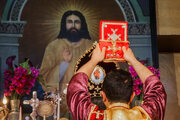Over 3 centuries have passed since the art of glass painting was born, and now to find a piece or frame of this art one should go from one city to the other, walk through the streets, follow the steps of a dervish and visit a saqqakhaneh (traditional public drinking place). You may look for it on shelves of old houses where the precious art has been preserved like old culture and tradition as a trust, the trust which reflected an image of generations living before us hundred years ago.
These are the works created by the faithful artists who had created sketches of history taken from religious beliefs by their creative minds and hands, despite their living problems and poverty on those days.
It is the art in which an artist in love of painting such as Seyyed Kazem Shirazi cut his finger for the blood he needed to use in painting the red blood of the martyrs of
An old Ardebili citizen said that people kept glass painting works in their houses based on their beliefs or offered them to saqqakhaneh or hosseynieh (site for seasonal religious ceremonies).
“Dervishes had the greatest interest in glass paintings on which portraits of Imams were sketched and used to carry them around,” added Miryadollah Mir Javadkhani.
He mentioned, “The tableaus of glass paintings were covered with green pieces of cloth and used to remove the cover and wash them with water, touching them on faces of the sick as good omen and blessing.
Deputy of Ardebil Cultural Heritage Department said glass painting began with the most spiritual school of painting of
Alireza Dabbagh Abdollahi added that after the Constitutional Revolution glass painting found its way in religious sites, and the believers used to order the works to put them in religious places.
Qorbanali Qorbani, Akbar Gilani, and Esmaeil Gilani are known as the prominent artists of glass painting.
RM/SRM
END
MNA





















Your Comment